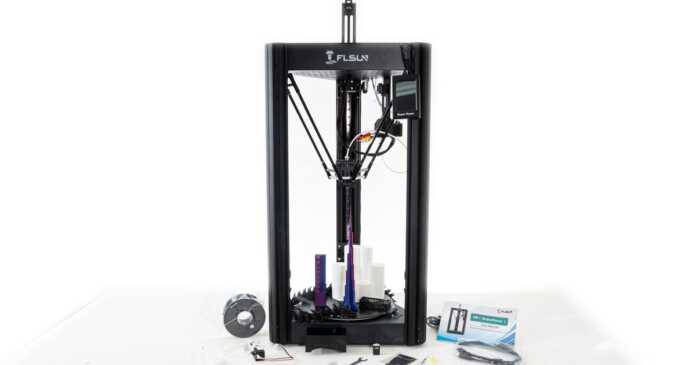Thanks to the delta construction, the Flsun Super Racer prints almost three times faster than other 3D printers that use the FDM process to melt plastic. He can also convince otherwise – there is only one catch.
In addition to the widespread 3D printers with a Cartesian structure – such as the popular Ender 3 v2 (test report) or the currently popular Anycubic Vyper (test report) , delta printers are exotic. They are considered complicated. Repairs are said to be difficult and the maximum size of the printed parts is limited due to the design and the resulting round print bed – so the myth goes.
The Austrian 3D printing specialist 3D Jake recommended the Flsun Superracer to us with the words “It’s coming” and made the test device available. We had already tested a comparable model, the Monoprice Mini Delta V2 (test report) , which convinced us with plug & play, good results and a reasonable price. The Flsun Super Racer has to work harder with a proud price of 499.00 euros.
It starts well. The Super Racer is well packaged, its metal frame is of high quality – and in addition to the printer, there are lots of practical accessories in the box. For such a highly complex mechanism, the printer has an amazingly simple structure. Even the print head is simply clipped in – that’s it! An attachable level sensor takes over the measurement of the print bed. Insert filament and you’re ready to go: This printer is also suitable for beginners.
And then we see: In Cura, the print speed is preset to 120 mm/s. Numbers like this make anyone with 3D printing experience uncomfortable. It is well known that if you want clean print results, the print speed should be between 35 and 60 mm/s. It was worth a try. And indeed: what the Flsun Super Racer then bangs out at 120 mm/s amazed even us.
Admittedly, the assembly is a little more complicated with a delta 3D printer than with the classic Cartesian structure. The Flsun Super Racer kit consists of the lower and upper platforms and the three guide rails. Rails and motors are already pre-assembled, as is the print head. There are also three double connecting rods made of carbon.
First of all, the guide rails are fixed to the upper frame with four screws each. Then attach the lower frame and repeat the procedure. Now the chassis is in place and we can start assembling the print head. This is simply clamped into the double guide rods made of carbon tubes. They are tensioned with springs and have opposite joint sockets at the end, which you simply clip into the joint heads of the print head and guide rail. The precisely pre-greased joint sockets were particularly pleasing.
So simply clamp the first double guide rod, hold the print head on the second and third. Then connect the construct to the articulated heads on the motor linear rails. That’s it. The construction of the most complicated part of the delta printer system is done. We imagined this to be more difficult – and we don’t know it from other printers as comfortably.
The next steps are to attach the extruder to the top and connect the cable ends from the top chassis to the printhead. Thanks to different color markings, this works easily and understandably. A cable socket initially remains unused for the calibration unit.
The white Bowden hose is stretched between the extruder and the print head, and the Flsun Super Racer is ready for use.
After it is switched on, the printer first needs to be calibrated. For this we need the small attachment supplied. This is clipped onto the print head from below and the cable is connected to the free white end of the cable. After that we start the auto leveling. The software asks whether the sensor is also clipped on. Once this has been confirmed, the Flsun Super Racer automatically measures its pressure bed. Don’t forget to remove the sensor afterwards. Evil voices claim that this has even happened to professionals like us. ahem.














